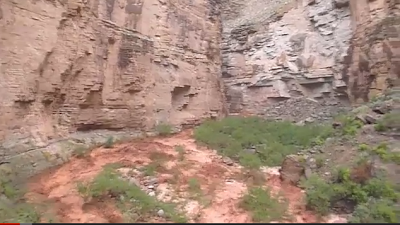Some video was captured of the big National Canyon flood, which occurred on July 14, 2012. It is courtesy of Joe Clark, a boatman for Western River Expeditions. That video can be viewed here. And there is a second video here that shows how the floodwater entered the Colorado as a foamy mess. These are amazing images. I have heard estimates that National Canyon had a peak flow of about 15,000 cubic feet per second, making it almost as large as the Colorado River on that day.
Another flood occurred very close to National Canyon but on the other side of the river at Fern Glen Canyon on August 20th, 2012. A river trip apparently had stopped to hike at Fern Glen but on the way up into the canyon, the extreme runoff filled the canyon bottom. That video can be watched here. I have heard no estimates of the discharge on this flood but it is quite a bit smaller that what came down National. Anyone who would have been caught in the narrows in Fern Glen Canyon however, would not have cared one bit if this flood was somewhat smaller - the amount of runoff is impressive and deadly.
Flash floods are common in landscapes that contain widespread bare rock exposures with few soils. They are the mechanism by which the canyons are created and facilitate the deep dissection that makes the Colorado Plateau and Grand Canyon so wonderful. With the advent of cheap but high quality electronics, more of these events are now visible to us. Watching the majesty and power of these events stirs the soul.
Addendum - 12/12/12: I became aware of this footage of the Red Canyon flood at Hance Rapid today! Here it is.



Thanks for posting these videos. I am always glad to be reminded about the power of rushing water. Nature bats last!
ReplyDeleteI received this update from Robert Tubbs on July 8, 2014:
ReplyDeleteI'm a fellow geologist and aficionado of Grand Canyon. You stated that the National flood occurred on July 14, 2012 and heard estimates "of a peak flow of 15,000 cfs." Curiously the record of the National flood event is quite subdued at the Diamond Creek gauge. It looks like it hit the gauge as the river was dropping and it reversed the drop for a short time and increased the flow to about 2,000 cfs above what it would have normally been. But then the after about 4 hours the river shows a normal gradient fall down to only 1,500 cfs above what would have been the normal low for the night of July 15. When the river began to rise from the low it could be argued it was as much as 4,500 cfs higher than normal, but any more than that would be a stretch.
Using available USGS data I'd guess no more than 6,000 to 8,000 cfs came down National and probably closer to 5,000 cfs. Granted the pulse of water created by the flood will even out and spread over time & distance, but observing the gauge response characteristics of other known floods in Grand Canyon it is unreasonable to expect the crest of the pulse to halve over 58 miles and approximately 5-6 hours of travel time.
Cheers,
--Robert Tubbs